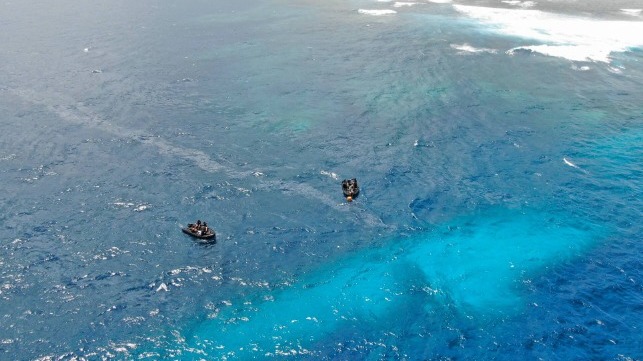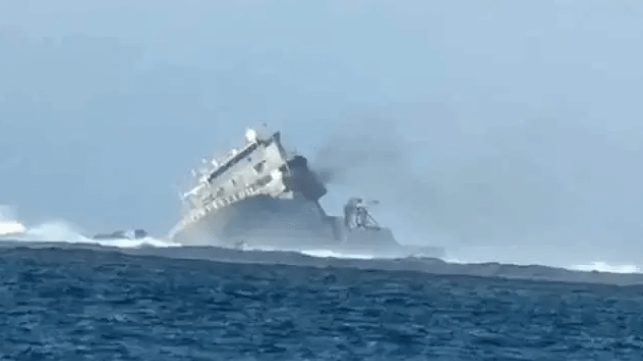Royal Navy Helps Recover Evidence After Loss of New Zealand Survey Ship
HMS Tamar raced to assist, and helped collect debris after the sinking - including the lost ship's deck log

New Zealand has thanked the Royal Navy for its help in responding to the sinking of the survey ship HMNZS Manawanui off Samoa.
HMNZS Manawanui ran aground while mapping waters around a reef on October 5, subsequently capsizing and sinking after all her crew had been safely evacuated.
HMS Tamar, which had just left Fiji on a patrol to stop illegal fishing activities in the region, was on her way to Samoa within a minute of receiving the call.
She arrived 23 hours later after a 650-mile dash at full speed through heavy seas – learning on the way that the Manawanui had sunk.
Tamar was still needed, however, to help with the aftermath of the sinking: protecting the wreck site, helping to prevent any illegal activities or snoopers, and helping New Zealand recover any official material/equipment and personal effects from the waters around Samoa.
The deputy head of the Royal New Zealand Navy Commodore Andrew Brown, who is in Samoa to oversee the recovery and relief operation, visited HMS Tamar when the British ship put into harbor to convey his nation’s gratitude to Commander Tom Gell and his sailors.
The fate of the Manawanui is particularly poignant for Tamar’s crew, who have worked with the ship this year and were treated to a traditional p?whiri – Maori greeting – from her sailors only last month when the British warship visited the New Zealand naval base in Devonport.
“The phone call from our headquarters was truly shattering,” said Commander Gell.
HMNZS Manawanui has run aground on a reef south of Upolou, they are abandoning ship, make best speed.
“Within one minute we had increased to maximum speed and were charging into the sea to reach them as quickly as possible,” Commander Gell continued.
“Manawanui were our host ship during our recent visit to Devonport – we know the team well and have also worked with them previously in Tonga. They are our friends and they are highly professional, fellow mariners.”The two ships had appeared side-by-side earlier this year at the International Fleet Review in Tonga.
While Tamar’s dash across the Pacific could not save the stricken New Zealand vessel, Commander Gell said there was widespread relief among his 50 crew when they learned all the Manawanui’s sailors had safely abandoned ship.
When the British ship arrived off the wreck site at sunrise on Sunday, the bridge team had expected to find the surrounding waters littered with flotsam: shipping containers and debris, plus a potential oil slick.
None of that was to be seen, but Tamar was soon directed to debris by a long-range Royal New Zealand Air Force P8 patrol aircraft, scouring the area. It was recovered and has been returned to the New Zealanders.
HMS Tamar will remain in support of the diving/recovery operation as long as she is needed.
“When we operate at sea, often a long way from help and support, we take a degree of risk. This is something that people who volunteer to serve in navies accept,” Commander Gell added. “When HMS Nottingham hit Wolf Rock in 2002, in the most dire situation, HMNZS Te Mana and other Royal New Zealand Navy assets were first on scene to render support to us."
Salvage of Lost Survey Ship Will Pause for King Charles' Visit to Samoa

The salvage response to the lost New Zealand Navy survey vessel HMNZS Manawanui will pause for a week while Samoa hosts a high-profile Commonwealth meeting, attended by King Charles III. The king's lodgings will be within a few miles of the wreck site, and work will be limited to observation and monitoring for the duration of his stay.
Prime Minister Fiame Naomi Mata'afa told reporters Friday that response work, including dive and coastline operations, would be paused for the duration of the conference.
As of Thursday, a contractor was preparing to remove three lost shipping containers from the reef off the coast of Tafitoala. The local contractor, ARK Marine, plans to float the boxes off the reef intact. One has already been emptied by responders; one contains trash, and the last one contains food. The boxes are small 10-foot units, but may be harder to move because of the site. "The containers are not watertight and have sustained some structural damage, and are being moved by tides and swell," the New Zealand Defence Force told local media.
The job is expected to take three days, NZDF spokesman Commodore Andrew Brown told New Zealand's 1News, assuming favorable weather conditions. It was unclear if the container removal element of the response would be paused, as suggested by Prime Minister Mata'afa.
New Zealand's military says that only a slight quantity of diesel fuel has escaped from the Manawanui's engine room, and that the ship's main tanks are intact. No shoreline impacts have been observed, and a minor surface slick seen from the air has been dissipating out at sea. However, local residents have been instructed not to fish in the area during the salvage operation, and many are upset about the risk of pollution. Samoa's economy is less developed, and many residents are dependent upon subsistence fishing for their income and sustenance.
Fishermen and tourism operators near the wreck site have called for compensation for loss of income, but New Zealand's government has so far resisted the question, suggesting that it is too early to understand the impact of the sinking - particularly since the evidence released so far suggests only limited amounts of pollution. This view is not shared by all local stakeholders: Samoa's Marine Pollution Advisory Committee believes that the ship lost about 200,000 liters of fuel, or about 17 percent of the 950 tonnes of diesel on board. The NZDF believes that the true size of the release was far smaller, since all of the main fuel tanks are undamaged.
No comments:
Post a Comment